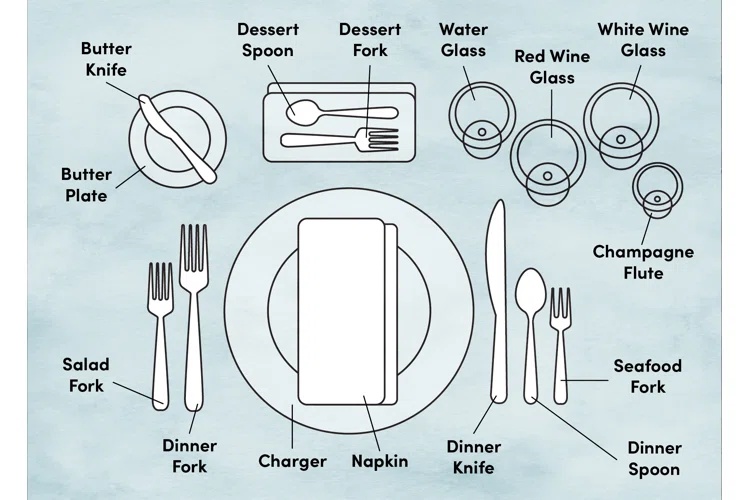Cutlery is an essential part of our daily dining experience, yet its meaning and significance often go unnoticed. From the simplest meals to the most elaborate feasts, cutlery plays a crucial role in ensuring a pleasant dining experience. This comprehensive guide will delve into the meaning of cutlery, explore its various types and uses, and provide a brief history of its development. By understanding cutlery better, you can enhance your dining experience and appreciate the craftsmanship and functionality of these everyday tools.
What is Cutlery?
Cutlery refers to hand utensils used in preparing, serving, and especially eating food. The term cutlery is derived from the Old French word "coutellerie" and the Middle English word "cuteller," meaning knife. Over time, the term has come to encompass a wide range of dining tools, including knives, forks, spoons, and other utensils.
Types of Cutlery
Cutlery comes in various types, each designed for specific functions. Here are the primary types of cutlery:
Knives
Dinner Knife: Used for cutting and pushing food. It typically has a slightly rounded blade.
Steak Knife: A sharp knife with a serrated edge, ideal for cutting through meats.
Butter Knife: A dull knife used for spreading butter or other spreads.
Forks
Dinner Fork: The most common type of fork, used for eating the main course.
Salad Fork: A smaller fork with slightly wider tines, used for salads.
Dessert Fork: Similar to a salad fork but usually has a narrower design.
Spoons
Soup Spoon: A large spoon with a round bowl, perfect for soups and broths.
Teaspoon: A small spoon used for stirring tea or coffee and measuring ingredients.
Dessert Spoon: Slightly larger than a teaspoon, used for eating desserts.
Specialty Utensils
Fish Knife and Fork: Designed for eating fish, with a knife that has a special blade for removing bones.
Cheese Knife: A knife designed to cut cheese, often with holes to prevent sticking.
Oyster Fork: A small fork used specifically for eating shellfish.
Uses of Cutlery
Cutlery is used in various ways depending on the type of meal and the cultural context. Here are some common uses:
Eating: The primary use of cutlery is to assist in the consumption of food. Each piece of cutlery has a specific function, such as cutting, spreading, scooping, or piercing food.
Serving: Certain types of cutlery are designed for serving food. For example, serving spoons and forks are used to transfer food from serving dishes to individual plates.
Cooking: Some cutlery items are used in food preparation, such as chef's knives, paring knives, and spatulas.
Decorative Purposes: In some cultures, cutlery is used for decorative purposes during formal dining occasions, adding elegance and style to the table setting.
The History of Cutlery
The history of cutlery dates back thousands of years. Here's a brief overview of its development:
Ancient Times: The earliest known cutlery items were made from stone, bone, and wood. These primitive tools were used for cutting and preparing food.
Bronze Age: During the Bronze Age, metal cutlery began to emerge. Bronze and copper were commonly used to make knives and other utensils.
Iron Age: The use of iron and later steel revolutionized cutlery production. Knives became sharper and more durable, and the development of forks and spoons followed.
Middle Ages: In medieval Europe, cutlery became more refined and decorative. Wealthy individuals often had personalized sets of cutlery made from precious metals.
Modern Era: The Industrial Revolution brought about mass production of cutlery, making it more accessible to the general population. Stainless steel became the material of choice due to its durability and resistance to corrosion.
How to Choose the Right Cutlery
Choosing the right cutlery can enhance your dining experience and complement your table setting. Here are some tips for selecting cutlery:
Material: Stainless steel is the most popular choice due to its durability, resistance to rust, and ease of maintenance. Silver and gold-plated cutlery are also available for those seeking a more luxurious option.
Design: Consider the design and style of the cutlery. Modern designs often feature sleek, minimalist lines, while traditional designs may have intricate patterns and embellishments.
Weight and Balance: The weight and balance of cutlery are important for comfort and ease of use. Heavier cutlery often feels more substantial, while well-balanced pieces make dining more enjoyable.
Purpose: Choose cutlery that suits your dining habits and needs. For example, if you frequently entertain guests, investing in a high-quality set of formal cutlery may be worthwhile.
Caring for Your Cutlery
Proper care and maintenance of your cutlery can extend its lifespan and keep it looking its best. Here are some tips for caring for your cutlery:
Washing: Most stainless steel cutlery is dishwasher safe, but hand washing is recommended to preserve the finish. Avoid using abrasive cleaners or scouring pads.
Drying: Dry cutlery immediately after washing to prevent water spots and corrosion. Use a soft cloth to wipe each piece thoroughly.
Storage: Store cutlery in a dry, cool place. Consider using a cutlery tray or organizer to keep pieces separated and prevent scratching.
Polishing: Periodically polish silver or gold-plated cutlery to maintain its shine. Use a soft cloth and a suitable polish designed for precious metals.
Conclusion
Understanding the meaning, types, and uses of cutlery can greatly enhance your dining experience and appreciation for these essential tools. Fancyware Ceramics offers a range of high-quality, beautifully designed cutlery to suit any occasion. By choosing the right cutlery and caring for it properly, you can enjoy the elegance and functionality of these everyday items for years to come.
For more information on sourcing high-quality cutlery and other tableware, visit the Fancyware Ceramics website or contact their sales team(Whatsapp: +8613935173210) directly for detailed inquiries.
